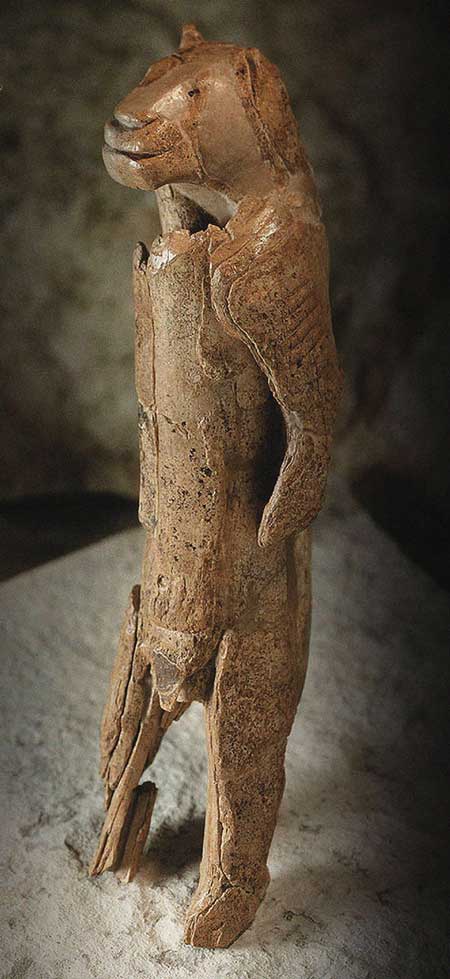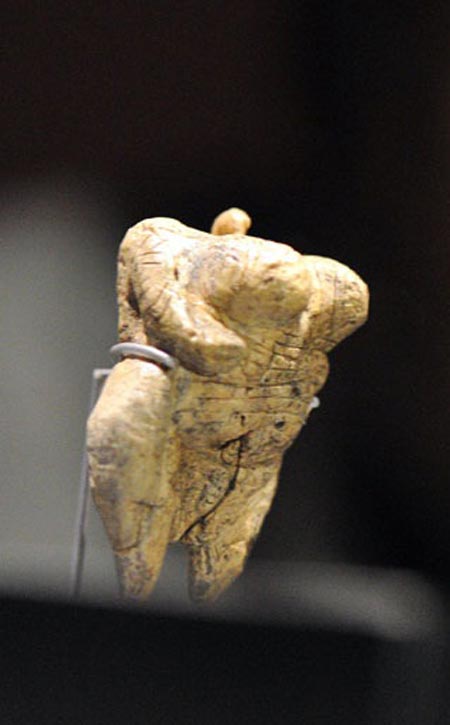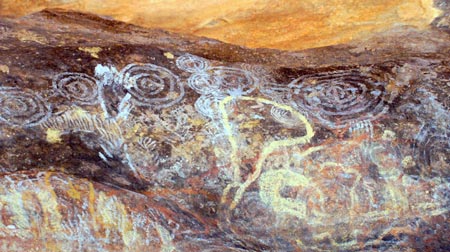How does the style of cave art change around the world?
We take so much for granted when we look at cave art. They are animals they hunted is often the common explanation, but is it that simple?
Can we really make any sense of the paintings and their subjects?
Rock art is not only restricted to the Palaeolithic Period, it has survived until today and can be seen in a number of cultures especially in the Australian Native art see Figure 1 below.
Figure 1: Australian native art at Uluru. Photo Pat O’Brien.
Figure 2 is an example of ancient cave art from another part of the world. This is from Africa. Look carefully and you will see hunters hunting cattle, but it leaves us with questions.

Figure 2: Rock painting at Tassili n’Ajjer, Algeria. © DPK-Photo / Alamy.
- Do the figures and animals movement make any sense?
Try to make a story to explain the action painted in the picture.
The painting seems to show a planned or tactical approach to hunting cattle in what must have been grassland and is now a desert region. This implies a climate change in the area and that the people who once lived here were organised groups or strategic hunters using bows and arrows and throwing sticks to bring down prey.
- Is the difference in the animals a difference in species or a difference in sex?
- Do animals like this survive today to help us interpret the drawing?
- Is it really art or is it a hunter’s aid?
- Isn’t the old cave art just an ‘instruction manual’ for young hunters?
- It is possible to make some interpretation of the art from the ancient cave people but isn’t the modern cave art just graffiti?
It is a difficult field to make sense of and much research has gone into this area. It is true we will never know for sure the full purpose of these art forms. However historians can theorise and put forward some hypotheses which allow us to form some tentative conclusions. Archaeologists’ interpretations largely depend on their own culture, experience and history.
Much of the excitement of this area of research lies in the way we conjecture on the scant evidence. In fact the British Museum put on an excellent exhibition that examined this area and they chose as a title ‘Ice Age Art: Arrival of the Modern Mind’. The implication being that the development of art in this period was a direct indication of the first expression of the human mind.
The primary aim of understanding the cave art consists of trying to fit the images found on rocks into some notional chronology. The theory is that, by defining their age, researchers can get deeper insights into the development of human culture and acquire a better understanding of past habits and lifestyle.
Is it possible to date these art forms?
The difficulty is the dating and there are two ways of dating these materials. One is by using an absolute method such as a chemical analysis of the materials against known time standards such as radiocarbon dating, or a relative method such as comparing the object with a known timed item such as analysing style.
A major problem lies in the dating of rock art using present absolute approaches. Radiocarbon dating is one of the most reliable methods. Its limitation is that it can only be used to put an age on organic matter that contains carbon. In rock art there is often not much carbon, only inorganic minerals.
In using ‘style’ as a dating method we not only refer to formal attributes in the painters style, but also to the distinction of superimpositions where one painter draws over another artists work over time and the differential weathering of the surface of the rock. This type of dating analysis can have different outcomes. In some cases it helps establish a chronology for yet undated images and engravings; in other cases it can be used as a complement to an absolute dating method to render classifications narrower.
Let’s start our study by looking at the physical evidence.
A study of the cave paintings from many places around Europe shows that the most common themes are large wild animals such as bison, horses, aurochs, and deer. Also notable are the many tracings of human hands and abstract patterns.
- Can the subjects of the painting act as dating tools?
- How accurate can such a method be?
The animal species shown in the art are most often those hunted, but not always. The actual prey found in local deposits of bones can often tell a different story. For example, at Lascaux the deposits of bones are mainly reindeer, but this animal is not portrayed in the cave paintings; the horse is the most common.
- Why should this be?
- Are they drawing the hunted or is the drawing for another purpose?
In some cases the animal form is incised into the rock or they use the contours of the rock to enhance the shape and form of the animal being drawn.
- Is this to emphasise the animal’s shape or is there another reason?
Drawings of humans in the cave paintings are rare and usually schematic rather than detailed natural images. Let us conjecture that the painting of the human form was prohibited by their religion; maybe it brought bad luck!
That may not be so far removed from serious study. After all, aren’t a lot of people worried by the number 13? So much so that in some hotels and offices there is no room 13. And we are supposed to be a sophisticated society!
The evidence suggests that they were not merely decorations of living areas, since the caves in which they have been found do not have signs of ongoing habitation. They are also often located in areas of caves that are not easily accessible. Some theories hold that cave paintings may have been a way of communicating with others, perhaps for teaching hunting, while other theories ascribe a religious or ceremonial purpose to them.
Some historical interpretations of cave art
Archaeologists determine what the cave art of the Palaeolithic people was about by considering objects found within their archaeological context. From that evidence they piece together a story that indicates something of the way of life of people who inhabited particular locales, and reflects their underlying thought processes.
Henri Breuil (1877–1961), known as Abbé Breuil, was a French Catholic priest, archaeologist, anthropologist, ethnologist and geologist. He studied the cave art in the Somme, Dordogne valleys, Spain, Portugal, Italy, Ireland, China, Ethiopia, Somalia (British Somaliland), and South Africa. Breuil was one of the first to interpret the cave paintings of the Palaeolithic. He saw them as a hunting magic whose purpose was to increase the number of animals caught.
Lewis-Williams (2009) worked on the South African cave paintings and advanced the theory that the paintings are the products of shamans. This is based upon his studies of contemporary hunter-gatherer societies. He argues that the majority of paintings are found in the darkness of the caves not the living areas. They are often in caverns where the echoing sound is good or the surface is such that the shadows of the rock help to give the painting form and shape. Because the shaman would enter a trance-like state to paint, the chanting and shadow movement would enhance the trance and images. In this way the contours of the rock would give animation to the drawing of an animal and this simulated motion would enhance the ‘magic’ of the animal.
R. D. Guthrie (2005) has taken a different route and reached a different view. He theorises that from a study of the art and skill point of view, there is a wide range of skill and a range of ages amongst the artists. From an analysis of the themes of the paintings, mainly hunting, it suggests that these paintings are the result of adolescent male fantasies.
This idea of the dominance of male artists is countered by D. Snow (2009) who has analysed the hand prints and stencils in French and Spanish caves and concludes from the size and shape that many of these are of female hands. Therefore the cave painters were both male and female.
The birth of the modern mind
There has been found over time a large number of both paintings and decorated artefacts such as stone, horn and ivory tools, flutes and statues.
- Why did so many societies spend so much time decorating the objects?
One suggestion is that the complexity of the Homo culture had evolved beyond that of any other species. This enabled them to develop a culture that is some societies developed into a statement of rank and/or fashion; but the question is why?
Thinking animals seem to develop the higher order thinking capacity to reason about the mental intentions and attitudes of others. This allows them to interpret the intentions of another and predict outcomes that become expressed in their actions; they have a theory of mind.
The difficulty of this theory of mind is that this is not unique to humans but is found in apes and some other animals as well. There is also much evidence that many species are capable of using this thinking for social attribution and deception, indicating a theory of mind.
- If the development of mind is the driving force did that change the way these people thought?
One suggestion is that the evolving hominid or human developed the capacity to relate to events and encode these events in their memory. These memories would allow a coordination of action related to those memories. Hence the memory is a factor in developing thinking or cognition. With brain enlargement the evolving hominid learnt the capability for self-triggered recall and the rehearsal of action. This amounts to a capability for a stream of thought in which one idea evokes another and another and so on. This stream of thought helped the development of logic in reasoning in problem solving.
This thinking process of representation followed by re-description, allowed the early hominids the ability to direct attention away from the external world and toward internal thoughts and planned actions that are encoded in the memory, and which can be accessed at will. This allows the individual to escape reality and provides a way of sharing knowledge and experience through imagination. This sharing of thoughts encouraged the development of a group culture and through this many forms of art appeared, including naturalistic cave paintings of animals, decorated tools and pottery, bone and antler tools with engraved designs, ivory statues of animals and sea shells, and personal decoration such as beads, pendants and perforated animal teeth, many of which may have indicated social status.
What the paintings display is that the human beings of that time were capable of thinking, reasoning and imagining. It would be fair to say they are communicating in pictures and symbols. These are the faculties of a brain with a well-developed pre-frontal cortex (the area at the front of the brain); in fact a modern mind. Art is the product of a modern mind.
Do we know which group of humans developed the modern mind?
The cave paintings of the Palaeolithic period are attributed to Homo sapiens living about 40,000 years ago. Homo sapiens were anatomically identical to modern humans, but differed significantly from the Homo neanderthalensis (Neanderthals). Neanderthals were around in Europe at the same time as Homo sapiens, who came in from Africa.
Neanderthals are not found in the fossil record after around 10,000 years ago indicating they had gone extinct. Recent genetic analysis has found Neanderthal genes in the genotype of modern humans indicating that there was probably genetic mixing. This has presented some problems in explaining how and why the Neanderthals disappeared from the fossil record.
The abrupt disappearance of the Neanderthals has led most researchers to conclude that they were driven to extinction through competition with Homo sapiens because of their greater linguistic competence and cultural sophistication.
If you would like to try producing your own cave painting then click here.
European cave art style
Alongside advanced development of language and culture was the appearance of cave art. None has been found that can be attributed to the Neanderthals so it has been attributed to the Homo sapiens. The painting style in Europe is often known as Franco-Cantabrian which is actually an archaeological term taken from the main area around the Pyrenees where many of the paintings have been found.
Franco-Cantabrian art uses a range of different techniques such as:
- painting with fingers;
- painting using sticks, and pads of fur or moss;
- daubing, dotting, and sketching with coloured minerals and charcoal;
- spray painting through spitting or blowing paint through hollow bone.
Pigments used were often red and yellow ochre, haematite, manganese oxide and charcoal.
If you would like to try creating your own paints similar to those used in the Palaeolithic era, then click on the links below:
Despite the simplicity of the materials and techniques the artists were skilful. They used combinations of pigments in a single drawing, they used foreshortening, shadowing, surface effects and overlapping.
There appears to be consideration, by the painter, for earlier paintings, so they did not destroy these but painted alongside or incorporated them into their own painting. From these paintings it is possible to determine the development of style over time. The drawings are elegant, lively, simple to view but accurate enough to determine the species that they were drawing. The fact that many of the caves show no sign of habitation leads many archaeologists to believe these drawings were ritualistic.
In some of the caves in Eastern Spain the style of art looks similar to that found in the caves of Africa which chimes with the view that the art is by Homo sapiens who came into Europe from Africa. There are small depictions of human as well as animal figures in various poses such as hunting, fighting, ceremonial or ritual, and domestic activities.
Other palaeolithic art forms
In France and east to Siberia, cave sculptures have been found of animals and mainly females who appear abnormal in proportion with enormous breasts. These are thought to be fertility goddesses.
One of the most famous sculptures found is a lion-headed figure, first called the lion man (see Figure 3a) (Löwenmensch, from the German: “lion human”). After further examination it was named the lion lady (again from the German Löwenfrau).
Carbon dating indicates this figure is 40,000 years old so it is the oldest known sculpture in the world. It is made from ivory and is animal shaped (zoomorphic). More recently it has been interpreted as anthropomorphic (giving human characteristics to an animal). This may be because it represents a deity.
Just as spectacular is the 35,000-year-old prehistoric sculpture of an exaggerated female form known as the Hohle Fels Venus (see Figure 3b). It was found in Germany and could be mankind’s earliest artistic attempt to represent itself. It is a 6-centimetre long depiction of a woman carved from mammoth ivory.
a) 
b) 
Figure 3: a) The Lion Man of Hohlenstein-Stadel and (b) Hohle Fels Venus. a) © Heritage Image Partnership Ltd / Alamy, b) © dpa Picture Alliance / Alamy.
Sadly very little Palaeolithic art has been found in Britain and that is thought to be a result of the damp climate. The humidity is thought to have destroyed any art there had been, however, some rock art in the form of engravings has been found. The most famous are the engravings of animals at Creswell Crags, Derbyshire dated to 12,000 years ago and the 14,000-year-old carving of a speared reindeer in a cave on the Gower Peninsula, Wales.
Downloads
Style in Cave Paintings
PDF, Size 0.31 mb


















